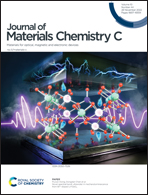Origin of polar nanoregions from displacive correlation in relaxor ferroelectric Pb(Mg1/3Nb2/3)O3–PbTiO3†
Abstract
The existence of polar nanoregions (PNRs) is widely accepted as a key signature of relaxor-ferroelectric solid solutions which display ultrahigh piezoelectricity. However, the exact structural model of PNRs is still under extensive debate. In this work, neutron atomic pair distribution function (PDF) analysis was performed to study the local-structural features of relaxor-ferroelectric (1 − x)Pb(Mg1/3Nb2/3)O3–xPbTiO3 with x = 0.28 (PMN–28PT) at low temperatures. The PDF profile reveals a much stronger correlation of atomic displacements in the very-short-r range structure compared with the medium- and long-r range matrixes. The structural modeling results suggest that the key factor differentiating the structures in the short- and medium-r ranges is the displacement correlation rather than the structural symmetry. Therefore, we conclude that the characteristics of the PNRs in PMN–28PT, including their formation and sizes, are governed by the displacive correlation. The temperature-dependent correlation change reflects the macroscopic dielectric properties. This finding provides a better understanding of the unique high-performance piezoelectric properties of relaxor-PbTiO3 materials.



 Please wait while we load your content...
Please wait while we load your content...